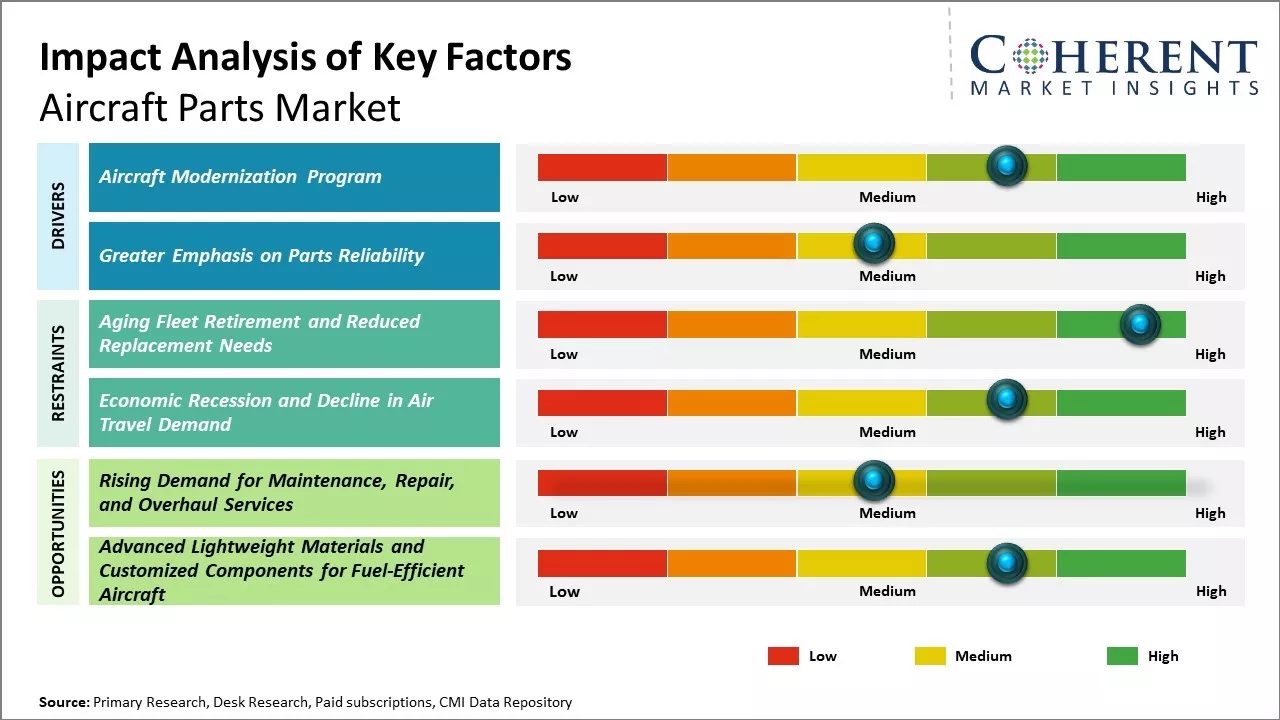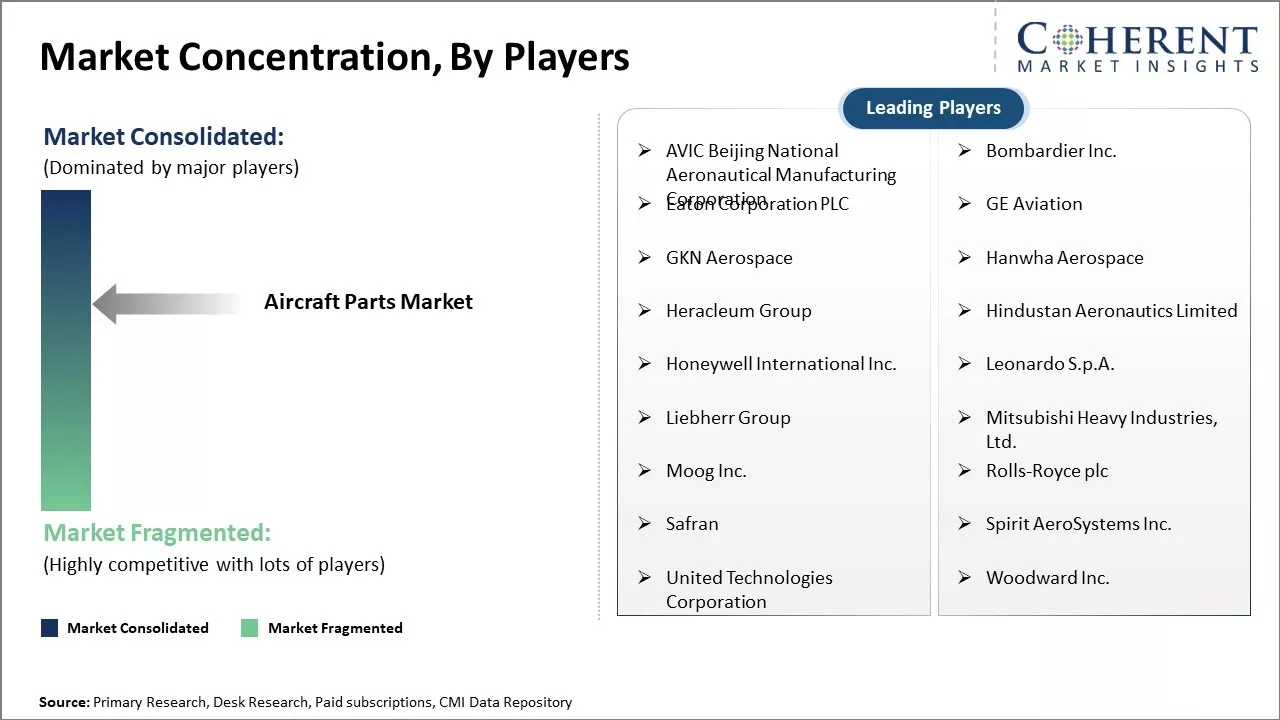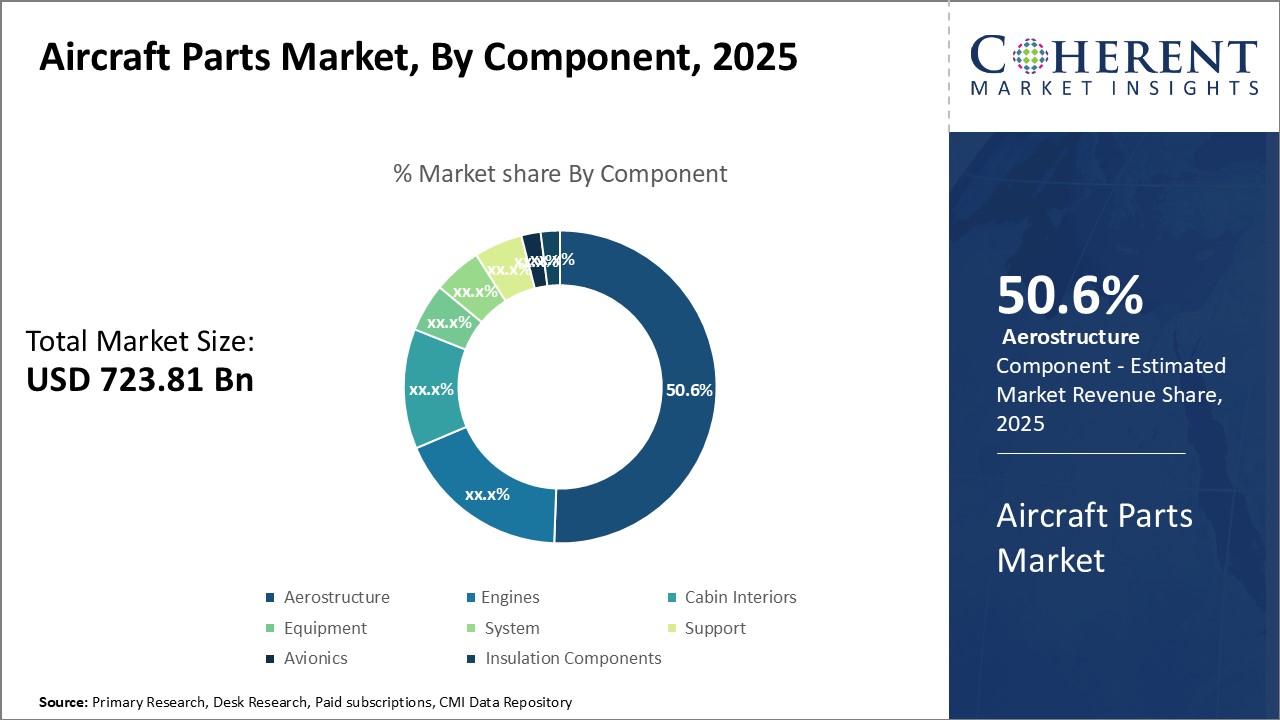The aircraft parts market is estimated to be valued at US$ 723.81 billion in 2025 and is expected to reach US$ 1,060.62 billion by 2032, exhibiting a compound annual growth rate (CAGR) of 5.6% from 2025 to 2032.

Discover market dynamics shaping the industry: Download Free Sample
The aircraft parts market is experiencing positive growth driven by factors such as the increasing global commercial aircraft fleet, demand for fuel-efficient replacement parts, and mandatory aircraft maintenance, repair, and overhaul activities. However, geopolitical risks, fluctuating raw material prices, and delays in aircraft deliveries are some challenges faced by the market. Key players are investing in designing lightweight and advanced materials to reduce costs and improve aircraft performance. Adoption of 3D printing and additive manufacturing is gaining traction in the production of aircraft components offer opportunities for customized designs with reduced waste. Overall, the market is driven by the need for increased air travel and mobility globally.
Aircraft Modernization Program
The commercial aviation industry has seen tremendous growth over the past few decades driven by increasing globalization and rising incomes in developing economies. Airlines around the world have ramped up the procurement of new aircraft to support their expansion plans as well as replace older fleet with modern and fuel-efficient planes. Aircraft manufacturers like Airbus and Boeing are reporting record backlogs for their narrowbody and widebody aircraft as airlines place large orders to accommodate traffic growth. This massive aircraft procurement drive has created robust demand for aircraft parts from manufacturers.
As the fleet of newer aircraft join the networks of major carriers, the demand for replacement parts to support the modern aircraft is rising. The sophisticated systems and components in new planes require advanced parts that must meet stringent quality and reliability standards. Manufacturers are investing heavily in developing cutting-edge components that improve fuel-efficiency, reduce maintenance turnaround times, and extend service life of assets. Several airlines are also entering into long-term partnerships with OEMs and MRO companies for comprehensive supplies management programs. This ensures a steady supply of genuine parts for predictable maintenance schedules and maximizes aircraft uptime. The lifecycle management of costly aircraft assets is driving greater reliance on manufacturers for customized parts and services packages.
For instance, in May 2023, Asia Digital Engineering (ADE), the engineering and maintenance subsidiary of Capital A, launched two groundbreaking digital solutions: AEROTRADE and ELEVADE FLEET. These platforms aim to revolutionize aircraft parts procurement and holistic aircraft health management in Asia, streamlining operations, enhancing efficiency, and elevating overall aviation industry performance.

Get actionable strategies to beat competition: Download Free Sample
Greater Emphasis on Parts Reliability
Another major factor aiding the aircraft parts market is the growing focus of regulators as well as carriers on operational reliability and safety. Any in-flight malfunctions or grounding issues translate to significant financial losses for airlines from delayed/cancelled flights besides damaging their reputation. The aviation authorities have hence tightened rules regarding use of unreliable parts on aircraft. They mandate that any replacement component must be equal or superior to the original part in quality and airworthiness. This pushes airlines and MROs to either rely only on authentic parts from OEM-authorized distributors or invest in stringent testing of alternative components. The need to avoid faults that can potentially endanger passengers has made carriers increasingly risk-averse about using unknown or low-cost parts.
For instance, on June 21, 2023, at the International Paris Air Show (SIAE), Capgemini an IT company, and Amazon Web Services (AWS) a cloud computing company, announced the launch of Lifecycle Optimization for Aerospace. This platform aims to accelerate the adoption of circular economy practices in the aviation industry by automating the inspection process, optimizing lifecycle analysis of aircraft parts, and guiding decisions to extend their lifespan. Major aviation sector players, including Air France and Safran, participated in its development and will be among the first users.
Key Takeaways of Analyst:
The aircraft parts market is expected to experience steady growth over the coming years. The rising number of air passengers globally is a major driver of demand for new aircraft and their components. Additionally, the growing preference for air travel in developing countries will propel the need for aftermarket replacement parts. North America currently dominates the market owing to heavy investments in aircraft fleet modernization by both commercial and military end users in the region. However, the Asia Pacific region is poised to be the fastest growing market for aircraft parts.
A key opportunity lies in the rise of no-frills carriers who opt for shorter replacement cycles and rely more on aftermarket parts to keep costs low. However, facing increased raw material prices amid supply chain disruptions post-pandemic could act as a near-term restraint. Strict aviation safety regulations also require aircraft parts to meet stringent quality and compliance standards, adding to production costs.
The growing MRO sector will drive the demand for replacement components. Major components such as engine parts and aircraft cabin interior products see higher replacement rates and present lucrative opportunities. However, the market also faces challenges around developing sustainable production processes to reduce the environmental impact. Overall, with the aviation sector on the path to recovery, the need for factory new parts and rotables will support continued aircraft parts market expansion globally.
Market Challenges: Aging Fleet Retirement and Reduced Replacement Needs
Airlines, driven by cost-cutting measures and a pursuit of enhanced fuel efficiency, are swiftly retiring older aircraft fleets. This trend significantly diminishes the demand for replacement parts within the aircraft parts market. The grounding of the Boeing 737 MAX further exacerbates this issue, as it directly reduces the demand for specific parts associated with this aircraft model.
Market Opportunities: Rising Demand for Maintenance, Repair, and Overhaul Services
Amid the current downturn in air travel leading to airlines shelving aircraft, there arises a significant market opportunity in the form of increased demand for maintenance, repair, and overhaul (MRO) services once the travel industry rebounds. As airlines resume operations and seek to optimize their fleets, the need for comprehensive MRO solutions will be paramount. This presents an opportunity for MRO service providers to capitalize on the anticipated surge in demand, offering efficient and reliable services to ensure the airworthiness and operational integrity of aircraft fleets.

Discover high revenue pocket segments and roadmap to it: Download Free Sample
Insights, By Component - Focus on Commercial Demand Drives Aerostructure Growth
In terms of component, aerostructure is expected to contribute the highest share of 50.6% in 2025, owing to strong demand from commercial aircraft manufacturers. Aerostructure parts such as wings, fuselage, and empennage see steady requirements as global air passenger traffic expands year after year. Low-cost carriers especially in Asia Pacific and Middle East have driven tremendous demand for newer narrowbody jets which has subsequently increased the demand for aerostructure parts. Established OEMs like Boeing and Airbus along with newer entrants like Comac in China have robust order books for several years to come which acts as a reliable source of business for aerostructure suppliers. Additionally, parts replacements and refurbishments for aging aircraft fleets also contribute to stable aftermarket sales. With air travel projected to double over the next two decades, commercial opportunities will ensure that continued focus on aerostructure remains high.
Insights, By Aircraft Type - Narrowbody Dominance from Proliferation of Short Haul Routes
In terms of aircraft type, narrowbody is expected to contribute the highest share of 64.6% in 2025, owing to their extensive use for short haul routes globally. Low-cost carriers cantered around key Asian hubs have expanded their fleets of A320 and 737 aircraft tremendously over the past decade. Similarly, full-service carriers too have optimized their domestic and regional networks with narrowbody aircraft. This has created a huge installed base for parts. Additionally, domestic connections within large countries like China and the U.S. rely heavily on narrowbody jets. With more routes being added each year within regions as well as internationally, demand for narrowbody aircraft and associated parts is expected to remain robust.
Insights, By Applications- Commercial Repairs and Maintenance Boosts the Application Segment
In terms of applications, commercial aircraft is expected to contribute the highest share of 53.7% in 2025, driven by the sizeable operational fleet and demanding repair/maintenance needs. With over 25,000 commercial aircraft in service worldwide logging millions of flight hours annually, the requirement for replacement parts is immense. Stringent reliability and safety regulations also mandate the regular replacement of certain parts. Furthermore, achieving aircraft uptime is critical for carriers and MRO service providers, generating a sustained demand for parts to facilitate repairs and maintenance turnarounds. Whereas military and business jet fleets are smaller in comparison, the commercial segment spends significantly higher on parts annually to achieve operational excellence.

Need a Different Region or Segment? Download Free Sample
North America has established itself as the dominant region in the global aircraft parts market. The region is expected to account for a market share of 35.6% in 2025. The key drivers propelling the North American aircraft parts market are the large fleet size and aging aircraft that are driving significant replacement demand for parts. The region is home to major aviation companies such as Boeing, General Electric Aviation, Honeywell, and Pratt & Whitney who have sustained their presence here for decades. This has created a robust supply chain ecosystem for components. Additionally, the region has seen steady orders for new commercial and military aircraft that need to be equipped and maintained. The strong domestic demand combined with exporting capabilities has made North America the preferred sourcing region for several aircraft parts globally. However, companies are facing pressure to reduce costs which is impacting pricing and market shares.
The Asia Pacific region has emerged as the fastest growing market with a CAGR of 7.2% for the forecast period of 2025-2031. Rapid economic growth and rising income levels in countries such as China and India have increased passenger traffic and propelled government investments to modernize fleets. Low labor costs and presence of cost-competitive suppliers have attracted several international OEMs to set up local manufacturing partners. This is enhancing the self-sufficiency of domestic carriers. For instance, many Chinese airlines now source a significant share of parts locally rather than from traditional import channels. The region also has ambitious plans to indigenize its defense aviation programs which will generate indigenous demand for components. While the market is at a nascent stage currently, projections indicate that Asia Pacific will witness the highest demand growth over the next decade. This makes it an attractive region for global parts manufacturers to gain an early advantage through investments and partnerships.
Aircraft Parts Market Report Coverage
| Report Coverage | Details | ||
|---|---|---|---|
| Base Year: | 2024 | Market Size in 2025: | USD 723.81 Bn |
| Historical Data for: | 2020 To 2024 | Forecast Period: | 2025 To 2032 |
| Forecast Period 2025 to 2032 CAGR: | 5.6% | 2032 Value Projection: | USD 1,060.62 Bn |
| Geographies covered: |
|
||
| Segments covered: |
|
||
| Companies covered: |
AVIC Beijing National Aeronautical Manufacturing Corporation, Bombardier Inc., Eaton Corporation PLC, GE Aviation, GKN Aerospace, Hanwha Aerospace, Heracleum Group, Hindustan Aeronautics Limited, Honeywell International Inc., Leonardo S.p.A., Liebherr Group, Mitsubishi Heavy Industries, Ltd., Moog Inc., Rolls-Royce plc, Safran, Spirit AeroSystems Inc., United Technologies Corporation, and Woodward Inc. |
||
| Growth Drivers: |
|
||
| Restraints & Challenges: |
|
||
Uncover macros and micros vetted on 75+ parameters: Get instant access to report
*Definition: The aircraft parts market includes companies that manufacture and distribute replacement parts and components for both commercial and military aircraft. Key products in this market include engines, landing gear, electronics, hydraulics, pneumatics, aircraft interiors, and structural components. Many companies specialize in specific parts like engine components, avionics systems, or fuselage panels. Aircraft parts are essential for maintaining, repairing, and retrofitting existing aircraft fleets.
Share
Share
About Author
Suraj Bhanudas Jagtap is a seasoned Senior Management Consultant with over 7 years of experience. He has served Fortune 500 companies and startups, helping clients with cross broader expansion and market entry access strategies. He has played significant role in offering strategic viewpoints and actionable insights for various client’s projects including demand analysis, and competitive analysis, identifying right channel partner among others.
Missing comfort of reading report in your local language? Find your preferred language :
Transform your Strategy with Exclusive Trending Reports :
Frequently Asked Questions
Joining thousands of companies around the world committed to making the Excellent Business Solutions.
View All Our Clients